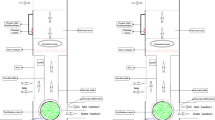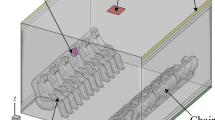Abstract
This study developed a computational fluid dynamics (CFD) model to assess the impact of the site of location of a commercial device (HEPA filter/ultraviolet light) on its capacity for microbial decontamination of indoor air. The three locations of the air decontamination device (ADD) in the aerobiology chamber were at the center, the middle of one of the lateral sides, and at the middle of the side in front of the axial air circulating fan. The findings were then compared to the experimental data generated in an earlier study on the same device using aerosolized Staphylococcus aureus as the challenge. The findings of the CFD model were strongly correlated to the experimental results, and the best site for the ADD was found to be at the middle of one of the lateral sides of the chamber. In this state, the microbial decontamination efficiency of the ADD was 99.46%. Additionally, this modeling study identified (a) the device’s optimal location in the chamber for microbial decontamination and the device’s effectiveness, (b) the axial fan’s location and its ability to uniformly distribute the airborne bacteria inside the chamber, and (c) suitability of the air samples collecting from the chamber’s center. The incorporation of this model could boost the design and construction of the chamber, reduce the need for laboratory experimentation, and also help to simulate and investigate an ADD’s efficacy for maximum reduction of airborne pathogens.




Similar content being viewed by others
References
Abduladheem A, Sahari KSM, Hasini H, Ahmed W, Mahdi RA (2013) Ventilation air distribution in hospital operating room-review. International Journal of Science and Research 2
Aganovic A, Steffensen M, Cao G (2019) CFD study of the air distribution and occupant draught sensation in a patient ward equipped with protected zone ventilation. Build Environ 162:106279
Association of Home Appliance Manufacturers (AHAM) (2002) In-house survey of homes in the United States. AHAM, Washington (DC)
Brown SK (1999) Assessing the performance of room air cleaners using a room environmental chamber. Proceedings of Indoor Air 2:647–652
Cai J, Yu W, Li B, Yao R, Zhang T, Guo M, Wang H, Cheng Z, Xiong J, Meng Q, Kipen H (2019) Particle removal efficiency of a household portable air cleaner in real-world residences: a single-blind cross-over field study. Energy and Buildings 203:109464
Chen L, Jin X, Yang L, Du X, Yang Y (2017) Particle transport characteristics in indoor environment with an air cleaner: the effect of nonuniform particle distributions. Build Simul 10(1):123–133
EPA (2001) Healthy Buildings, Healthy People, a Vision for the 21st Century. U.S. Environmental Protection Agency, Washington, D.C.
Faulkner WB, Memarzadeh F, Riskowski G, Hamilton K, Chang CZ, Chang JR (2013) Particulate concentrations within a reduced-scale room operated at various air exchange rates. Build Environ 65:71–80
Faulkner WB, Memarzadeh F, Riskowski G, Kalbasi A, Chang ACZ (2015) Effects of air exchange rate, particle size and injection place on particle concentrations within a reduced-scale room. Build Environ 92:246–255
Gołofit-Szymczak M, Stobnicka-Kupiec A, Górny RL (2019) Impact of air-conditioning system disinfection on microbial contamination of passenger cars. Air Qual Atmos Health 12:1127
Haghighat F, Jiang Z, Wang JCY, Allard F (1992) Air movement in buildings using computational fluid dynamics. Journal of Solar Energy Engineering 114(2):84–92
Hwang SH, Park WM (2019) Indoor air quality assessment with respect to culturable airborne bacteria, total volatile organic compounds, formaldehyde, PM10, CO2, NO2, and O3 in underground subway stations and parking lots. Air Quality, Atmosphere & Health 12(4):435–441
Ijaz MK, Zargar B, Wright KE, Rubino JR, Sattar SA (2016) Generic aspects of the airborne spread of human pathogens indoors and emerging air decontamination technologies. Am J Infect Control 44(9 Suppl):S109–S120
Ji L, Pei J, Liu W (2019) Long-term performance of fibrous ventilation/air-cleaner filters for particle removal. Build Environ 160:106222
Jin X, Yang L, Du X, Yang Y. Particle transport characteristics in indoor environment with an air cleaner. Indoor and Built Environment 2016; 25(6)
Johansson JHP (2000) Impact of room air cleaners on the indoor particle concentration. Proceedings of Healthy Buildings 2:59–60
Kang SY, Siegel J, Novoselac A (2008) Effective position of portable air cleaning devices in multizone residential buildings. Indoor Air 644:1–8
Liddament MW. A review of building air flow simulation. Technical Note AIVC33. Air Infiltration and Ventilation Center. Coventry, Great Britain: University of Warwick Science Park; 1991
Ma H, Shen H, Shui T, Li Q, Zhou L (2016) Experimental study on ultrafine particle removal performance of portable air cleaners with different filters in an office room. Int J Environ Res Public Health 13(102):1–15
Mehryan SAM, Kashkooli MF, Soltani M (2018) Comprehensive study of the impacts of surrounding structures on the aero-dynamic performance and flow characteristics of an outdoor unit of split-type air conditioner. Build Simul 11(2):325–337
Memarzadeh F, Xu W (2012) Role of air changes per hour (ACH) in possible transmission of airborne infections. Build Simul 5:15–28
Miller-Leiden S, Lobascio C, Nazaroff WW, Macher JM (1996) Effectiveness of in-room air filtration and dilution ventilation for tuberculosis infection control. Journal of Air Waste Management Association 46(9):869–882
Nazaroff WW (2000) Effectiveness of air cleaning technologies. Proceedings of Healthy Buildings 2:49–54
Nelson PR, Sears SB, Heavner DL (1993) Application of methods for evaluating air cleaner performance. Indoor and Built Environment 2(2):111–117
Niu J, Tung TCW, Chui VWY (1998) Using large environmental chamber technique for gaseous contaminant removal equipment test. ASHRAE Trans 104(2):1289–1296
Noh KC, Oh MD (2015) Variation of clean air delivery rate and effective air cleaning ratio of room air cleaning devices. Build Environ 84:44–49
Noh KC, Yook SJ (2016) Evaluation of clean air delivery rates and operating cost effectiveness for room air cleaner and ventilation system in a small lecture room. Energy and Buildings 119:111–118
Novoselac A, Siegel JA (2009) Impact of placement of portable air cleaning devices in multizone residential environments. Build Environ 44:2348–2356
Pei J, Dong C, Liu J (2019) Operating behavior and corresponding performance of portable air cleaners in residential buildings, China. Build Environ 147:473–481
Qian H, Li Y, Sun H, Nielsen PV, Huang X, Zheng X (2010) Particle removal efficiency of the portable HEPA air cleaner in a simulated hospital ward. Build Simul 3:215–224
Sattar SA, Kibbee RJ, Zargar B, Wright KE, Rubino JR, Ijaz MK (2016) Decontamination of indoor air to reduce the risk of airborne infections: studies on survival and inactivation of airborne pathogens using an aerobiology chamber. Am J Infect Control 44(10):e177–e182
Sattar SA, Zargar B, Wright KE, Rubino JR, Mk I (2017) Airborne pathogens inside automobiles for domestic use: assessing in-car air decontamination devices using staphylococcus aureus as the challenge bacterium. Appl Environ Microbiol 83:275–282
Shaughnessy RJ, Sextro RG (2006) What is an effective portable air cleaning device? A review. J Occup Environ Hyg 3(4):169–81
Siegel JA (2016) Primary and secondary consequences of indoor air cleaners. Indoor Air 26(1):88–96
Soltani M, Dehghani-Sanij A, Sayadnia A, M. Kashkooli F, Gharali K, Mahbaz SB, Dusseault MB (2018) Investigation of Airflow Patterns in a New Design of Wind Tower with a Wetted Surface. Energies 11(5):1100
Sultan ZM, Nilsson GJ, Magee RJ (2011) Removal of ultrafine particles in indoor air: Performance of various portable air cleaner technologies. HVAC&R Research:17(4)
Tong X, Wang B, Dai WT, Cao JJ, Ho SSH, Kwok TCY, Lui KH, Lo CM, Ho KF (2018) Indoor air pollutant exposure and determinant factors controlling household air quality for elderly people in Hong Kong. Air Quality, Atmosphere & Health 11(6):695–704
EPA guidlines (2012) Air sanitizers—efficacy data recommendations. (Test Guideline No. OCSPP 810.2500-Air Sanitizers-2013-03-12 [EPA 730-C-11- 003]; Available from:http://www.noticeandcomment.com/-ocspp-810-2500-air-sanitizers-2013-03-12-epa-730-c-11-003-fn-24288.aspx). Accessed 4 Dec 2015
Ward M, Siegel JA, Corsi RL (2005) The effectiveness of standalone air cleaners for shelter-in-place. Indoor Air 15(2):127–34
Zargar B, Kashkooli MF, Soltani M, Wright KE, Ijaz MK, Sattar SA (2016) Mathematical modeling and simulation of bacterial distribution in an aerobiology chamber using computational fluid dynamics. Am J Infect Control 44:e127–e137
Zargar B, Sattar SA, Rubino JR, Ijaz MK (2019) A quantitative method to assess the role of indoor air decontamination to simultaneously reduce contamination of environmental surfaces: testing with vegetative and spore-forming bacteria. Lett Appl Microbiol 68(3):206–211
Zhai Z, Osborne AL (2013) Simulation-based feasibility study of improved air conditioning systems for hospital operating room. Front Architect Res 2(4):468–475
Zhan Y, Johnson K, Norris C, Shafer MM, Bergin MH, Zhang Y, Zhang J, Schauer JJ (2018) The influence of air cleaners on indoor particulate matter components and oxidative potential in residential households in Beijing. Sci Total Environ 626:507–518
Zhang TT, Wang S, Sun G, Xu L, Takaoka D (2010) Flow impact of an air conditioner to portable air cleaning. Build Environ 45:2047–2056
Zhao J, Yang X (2003) Photocatalytic oxidation for indoor air purification: a literature review. Build Environ 38:645–654
Zhao B, Zhang Z, Li XT (2005) Numerical study of the transport of droplets or particles generated by respiratory system indoors. Build Environ 40(8):1032–1039
Zuraimi MS, Nilsson GJ, Magee RJ (2011) Removing indoor particles using portable air cleaners: implications for residential infection transmission. Build Environ 46:2512–2519
Acknowledgments
We are grateful to RB for conceptualizing this investigation.
Funding information
This study was supported in part by funding from RB (Montvale, New Jersey),
Author information
Authors and Affiliations
Corresponding author
Additional information
Publisher’s note
Springer Nature remains neutral with regard to jurisdictional claims in published maps and institutional affiliations.
Electronic supplementary material
ESM 1
(DOCX 6072 kb)
Rights and permissions
About this article
Cite this article
Moradi Kashkooli, F., Soltani, M., Zargar, B. et al. Analysis of an indoor air decontamination device inside an aerobiology chamber: a numerical-experimental study. Air Qual Atmos Health 13, 281–288 (2020). https://doi.org/10.1007/s11869-019-00782-w
Received:
Accepted:
Published:
Issue Date:
DOI: https://doi.org/10.1007/s11869-019-00782-w




